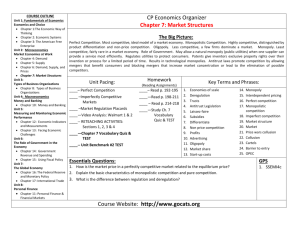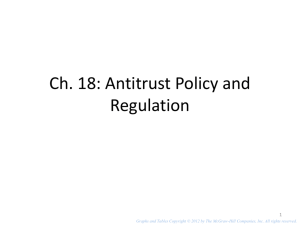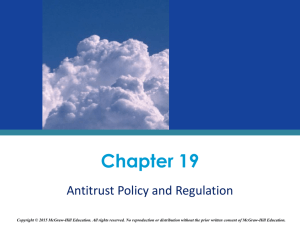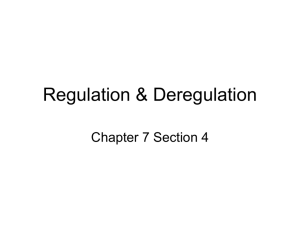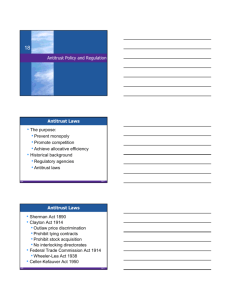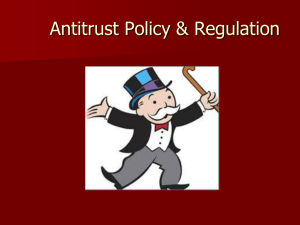Rose-Hulman Institute of Technology / Department of Humanities & Social... SV351, Managerial Economics / K. Christ
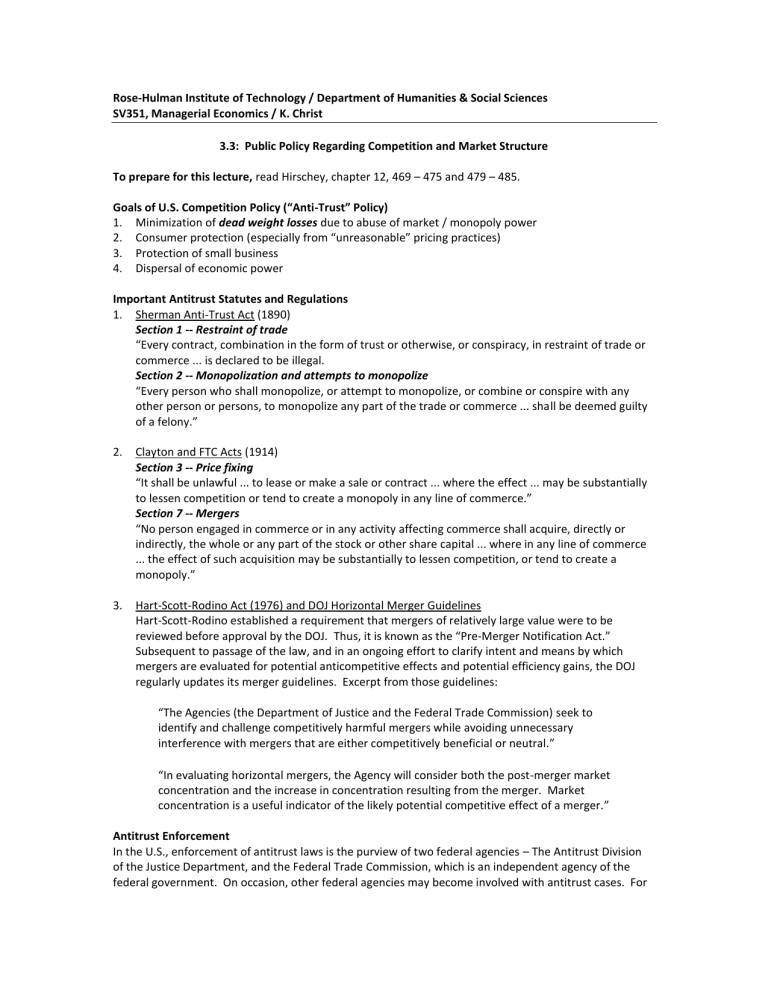
Rose-Hulman Institute of Technology / Department of Humanities & Social Sciences
SV351, Managerial Economics / K. Christ
3.3: Public Policy Regarding Competition and Market Structure
To prepare for this lecture, read Hirschey, chapter 12, 469 – 475 and 479 – 485.
Goals of U.S. Competition Policy (“Anti-Trust” Policy)
1.
Minimization of dead weight losses due to abuse of market / monopoly power
2.
Consumer protection (especially from “unreasonable” pricing practices)
3.
Protection of small business
4.
Dispersal of economic power
Important Antitrust Statutes and Regulations
1.
Sherman Anti-Trust Act (1890)
Section 1 -- Restraint of trade
“Every contract, combination in the form of trust or otherwise, or conspiracy, in restraint of trade or commerce ... is declared to be illegal.
Section 2 -- Monopolization and attempts to monopolize
“Every person who shall monopolize, or attempt to monopolize, or combine or conspire with any other person or persons, to monopolize any part of the trade or commerce ... shall be deemed guilty of a felony.”
2.
Clayton and FTC Acts (1914)
Section 3 -- Price fixing
“It shall be unlawful ... to lease or make a sale or contract ... where the effect ... may be substantially to lessen competition or tend to create a monopoly in any line of commerce.”
Section 7 -- Mergers
“No person engaged in commerce or in any activity affecting commerce shall acquire, directly or indirectly, the whole or any part of the stock or other share capital ... where in any line of commerce
... the effect of such acquisition may be substantially to lessen competition, or tend to create a monopoly.”
3.
Hart-Scott-Rodino Act (1976) and DOJ Horizontal Merger Guidelines
Hart-Scott-Rodino established a requirement that mergers of relatively large value were to be reviewed before approval by the DOJ. Thus, it is known as the “Pre-Merger Notification Act.”
Subsequent to passage of the law, and in an ongoing effort to clarify intent and means by which mergers are evaluated for potential anticompetitive effects and potential efficiency gains, the DOJ regularly updates its merger guidelines. Excerpt from those guidelines:
“The Agencies (the Department of Justice and the Federal Trade Commission) seek to identify and challenge competitively harmful mergers while avoiding unnecessary interference with mergers that are either competitively beneficial or neutral.”
“In evaluating horizontal mergers, the Agency will consider both the post-merger market concentration and the increase in concentration resulting from the merger.
Market concentration is a useful indicator of the likely potential competitive effect of a merger.”
Antitrust Enforcement
In the U.S., enforcement of antitrust laws is the purview of two federal agencies – The Antitrust Division of the Justice Department, and the Federal Trade Commission, which is an independent agency of the federal government. On occasion, other federal agencies may become involved with antitrust cases. For
Rose-Hulman Institute of Technology / Department of Humanities & Social Sciences / K. Christ
SV351, Managerial Economics / 3.3: Antitrust & Regulation example, the Federal Communications Commission has been involved in merger oversight when proposed mergers have involved media companies. Actual antitrust enforcement is a complicated mixture of the laws themselves, legal precedents established by courts in actual cases, and the vigor with which cases are pursued, which is influenced by politics and agency leadership. Figure 1 summarizes this process.
Figure 1: Antitrust Enforcement in the U.S.
Regulation and Deregulation
Regulation refers to the participation by governments, either directly or indirectly through government agencies and commissions, in the decision making processes of businesses and individuals. The impetus for government intervention may be purely economic, or it may stem from broader social or environmental concerns. Worker safety and environmental protection laws influence business decision making as much as direct economic regulation (of prices, for example). From an industrial organization perspective, regulation is one of four possible social responses to the existence of market power, the other three being public sector provision (nationalization), antitrust (or pro-competitive) laws, and acquiescence.
Broadly speaking, there are two schools of thought on the existence of regulation in a mixed market economy. The first explanation is that regulation arises as a response to some market failure, and that it is carried out in "the public interest." The second explanation is that regulation is an economic good of value to certain groups in society, and that various levels of government are suppliers of this good.
1
Deregulation is the reduction or elimination of government power in a particular industry, usually enacted to create more competition within the industry. In the United States, a general movement toward deregulation gathered steam in the 1970s, leading to a series of legislative changes that resulted in the deregulation of some notable industries. In particular, the U.S. Airline Deregulation Act of 1978 was the first in what has become a series of changes that have dismantled government oversight of industries.
Since then, the trucking, telecommunications, banking, and electricity industries have all undergone various levels of deregulation. Economic arguments in favor of deregulation generally proceed along efficiency lines, but differences of opinion exist concerning the overall welfare effects of deregulation.
1
Stigler, George, “The theory of economic regulation.” Bell Journal of Economics 2 (1971): 3-21; Posner,
R., “Taxation by Regulation.” Bell Journal of Economics 2 (1971): 22-50; Posner, R., “Theories of Economic
Regulation.” Bell Journal of Economics 5 (1974): 335-358; Peltzman, Sam, “Toward a More General
Theory of Regulation.” Journal of Law and Economics 19 (August 1976): 211-240.
Rose-Hulman Institute of Technology / Department of Humanities & Social Sciences / K. Christ
SV351, Managerial Economics / 3.3: Antitrust & Regulation
Public Interest Theories of Regulation. Generally, public interest explanations of regulation are a form of normative analysis because they justify the existence of regulation via claims that regulatory responses to specific situations result in improvements to social welfare. These explanations view regulation as a process carried out in the public interest as a response to market failure. A market failure justification generally requires three things:
• Proof of the existence and significance of market failure.
• Determination that correction is feasible. This entails identifying a regulatory framework in which profit maximization leads to the desired social outcomes.
• Cost-benefit analysis. The benefits of regulation (improved allocative efficiency) must be balanced against the costs of regulation.
The natural monopoly or efficiency dilemma. Figure 2 presents the standard depiction of the natural monopoly problem. Left on its own, the monopoly will produce output equal to q
M
, which will result in a price of p
M
, and the monopolist will earn profits equal to area A. The allocatively efficient output (the social optimum) is q
2
. At this output, the market price would be economic loss equal to area B. p
2
, and the monopolist would incur an
Figure 2: Natural Monopoly
One potential solution to the dilemma portrayed in Figure 2 is for the government to provide a subsidy equal to area B.
Alternatively, an output level of q
1
, with the associated market price of p
1
, represents a potential compromise solution between the extremes of monopoly control and public subsidization. This outcome maximizes social benefits subject to the constraint that profits cannot be negative. Such an outcome guarantees normal economic profit, which is sufficient to attract private capital into the industry. This approach, generally known as rate-of-return or cost-of service (COS) regulation, seeks to guarantee investors “reasonable” rates of return on their investments in private natural monopolies. In the U.S., such processes are typically overseen by state-level public service commissions .

